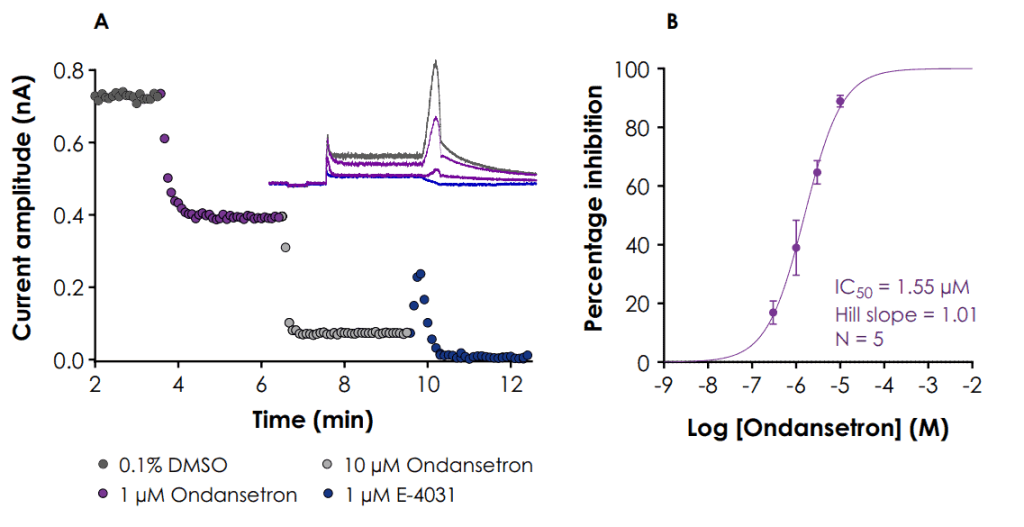

Non-GLP hERG Screening
Eliminate cardiac risk liability before lead development
With a hit rate of ~30% observed across the industry (Brennan et al. 2024) hERG channels have a high off-target hit rate that has a well-documented link to life-threatening cardiac arrythmias including Torsade de Pointes. Therefore, screening of novel compounds is essential to eliminate this liability early, before lead development, where it becomes more challenging to address.
Early hERG screening
Early profiling does not require GLP hERG testing, however, it is crucial to follow optimal protocols to ensure accurate assessment of the half-maximal inhibitory concentration (IC50) of a compound against hERG. This includes using the optimal profiling platform to ensure accurate, high-quality assessment of potency, while maintaining ample throughput, turnaround time and cost effectiveness.
This early screening supports efficient resource allocation and informed decision-making, ultimately contributing to the successful development of safer drugs.
- Early risk identification: Non-GLP hERG screening helps identify potential cardiac liabilities of compounds early in the drug development process. This early identification allows for the elimination of problematic compounds before significant resources are invested in their development.
- Cost efficiency: Conducting hERG screening in a non-GLP environment is less expensive than GLP-compliant studies. Early-stage, cost-effective screening helps manage budgets more effectively, especially when dealing with a large number of compounds.
- Rapid turnaround: Non-GLP screening can be conducted more quickly than GLP studies. This rapid turnaround time is crucial for early-stage decision-making and helps accelerate the drug development process.
- High-throughput: Non-GLP screening often utilize automated patch clamp systems, allowing for higher throughput screening. This efficiency is more cost effective and enables the assessment of many compounds in a short period. This strategy is particularly beneficial during the early discovery phase when numerous candidates are being evaluated.
- Optimization of lead compounds: By identifying hERG liabilities early, researchers can modify lead compounds to mitigate these risks. This iterative process of optimization via medicinal chemistry efforts can be done more quickly and efficiently in a non-GLP setting.
- Strategic decision making: Early non-GLP hERG screening data informs strategic decisions about which compounds to advance to more costly and time-consuming GLP studies. This strategic filtering ensures that only the most promising candidates proceed further.

Ion channel screening resource library
Publications
- Ion Channel Drug Discovery and Modern Medicine.
- Ion Channel Discovery – Partnering to Access Specialized Expertise.
- Recent advances in electrophysiology-based screening technology and the impact upon ion channel discovery research.
- Clathrodin, hymenidin and oroidin, and their synthetic analogues as inhibitors of the voltage-gated potassium channels.
- Novel K+ Channel Targets in Atrial Fibrillation Drug Development – Where Are We?
- Human Electrophysiological and Pharmacological Properties of XEN-D0101: A Novel Atrial-Selective Kv1.5/IKur Inhibitor.
Videos and Presentations
- Designing multiple assay protocols for ligand gated ion channels using the stacked-tip feature on the Patchliner and SP384i platforms
- The benefits of targeting ion channels for pain and some of the hurdles in developing successful ion channel modulators.
Posters
- Identification of Novel Scorpion Venom Peptide Inhibitors of the Kv1.3 Ion Channel and their Potential as Drug Discovery Leads for Human T-Cell Mediated Disease.
- The development of a set of novel small molecule inhibitors of the Kv1.3 ion channel.
- A drug discovery collaboration between Japanese pharma and a UK SME CRO successfully developed novel small molecule inhibitors of the Kv1.3 channel to treat autoimmune disease.
Application notes and resources
- ASIC1a Ligand Gated Ion Channel Assay (App Note)
- Investigating the correlation between thallium flux and automated patch-clamp for ion channel activators.
- Identification of novel ion-channel binders: TRPA1 antagonist case study.
- The development of a set of novel small molecule inhibitors of the Kv1.3 ion channel.
- Cross-site and cross-platform variability of automated patch clamp assessments of drug effects on human cardiac currents in recombinant cells.
- A systematic strategy for estimating hERG block potency and its implications in a new cardiac safety paradigm
- The Nav 1.5 Late Current in WT and Nav 1.5 ΔKPQ Mutant Channels: An Automated Patch Clamp LQT3 Electrophysiological Assay Comparison. Safety Pharmacology Society Virtual Meeting 2020.
- NaV1.5-ΔKPQ late INa current properties and pharmacology on the SyncroPatch 384i
- Recent advances in targeting ion channels to treat chronic pain.
- Marc Rogers (Metrion Director and Former CSO) takes part in a collaborative webinar with Nanion Technologies entitled “Validation and optimization of automated patch clamp voltage-gated Ca2+ channel assays”.
- Open access to the KCNQ channel: Retigabine and second generation M-current openers.
- Development of native and stem cell-derived electrophysiological assays for neurotoxicology screening and translational drug discovery
- Characterization of Endogenous Sodium Channels in the ND7-23 Neuroblastoma Cell Line: Implications for Use as a Heterologous Ion Channel Expression System Suitable for Automated Patch Clamp Screening.
- Optimising a difficult Nav1.8 cell line assay for automated patch clamp screening. Ion Channel Retreat, Vancouver, 2015
- Synthesis and biological evaluation of piperazine derivatives as novel isoform selective voltage-gated sodium (Nav) 1.3 channel modulators
- Action of Clathrodin and Analogues on Voltage-Gated Sodium Channels
- Novel state-dependent voltage-gated sodium channel modulators, based on marine alkaloids from Agelas sponges
- Ligand- and structure-based virtual screening for clathrodin-derived human voltage-gated sodium channel modulators
- The role of Nav1.7 in human nociceptors: insights from human induced pluripotent stem cell-derived sensory neurons of erythromelalgia patients
- Assessment of human induced pluripotent stem cell-derived cardiomyocytes for evaluating drug-induced arrhythmias with multi-electrode array
- Development of an impedance based screening assay for cardiac safety and cardiotoxicity detection in stem cell derived cardiomyocytes
- Validation of an impedance-based phenotypic screening assay able to detect multiple mechanisms of chronic cardiotoxicity in human stem cell-derived cardiomyocytes
- Electrophysiological characterisation of Cellular Dynamics International ventricular iCell2 iPSC-derived cardiomyocytes
- Functional characterisation of human iPSC-derived atrial cardiomyocytes

Let’s work together
What are your specific GLP hERG Screening requirements?
If you have any questions, or would like to discuss your project, we will put you directly in touch with a member of our scientific team. Contact us today to discover more.
